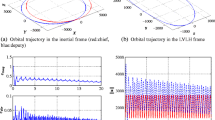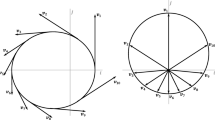Abstract
The method of data augmentation, in the form ofa priori covariance information on the reference solution, as a means to overcome the effects of ill-conditioning in orbit determination problems has been investigated. Specifically, for the case when ill-conditioning results from parameter non-observability and an appropriatea priori covariance is unknown, methods by which thea priori covariance is optimally chosen are presented. In problems where an inaccuratea priori covariance is provided, the optimal weighting of this data set is obtained. The feasibility of these ‘ridge-type’ solution methods is demonstrated by their application to a non-observable gravity field recovery simulation. In the simulation, both ‘ridge-type’ and conventional solutions are compared. Substantial improvement in the accuracy of the conventional solution is realized by the use of these ridge-type solution methods. The solution techniques presented in this study are applicable to observable, but ill-conditioned problems as well as the unobservable problems directly addressed. For the case of observable problems, the ridge-type solutions provide an improvement in the accuracy of the ordinary least squares solutions.
Similar content being viewed by others
References
Argentiero, P. D.: 1978,On Least Squares Collocation. NASA TM 75975, June.
Bock, Y.: 1982. ‘The Use of Baseline Measurements and Geophysical Models for the Estimation of Crustal Deformations and the Terrestrial Reference System’. The Department of Geodetic Science and Surveying Report No. 337, The Ohio State University Research Foundation.
Brown, K. G.: 1978, ‘On Ridge Estimation in Rank Deficient Models’,Communications in Statistics-Theory and Methods,A7(2), 187–192.
Chipman, J. S.: 1964, ‘On Least Squares with Insufficient Observations’,Journal of the American Statistical Association,59, 1073–1111.
Cicci, D. A.: 1987, ‘OptimalA priori Covariance Selection for the Solution of Ill-Conditioned Nonlinear Inverse Problems’. Doctoral Dissertation, The University of Texas at Austin, Department of Aerospace Engineering and Engineering Mechanics, August.
Efron, B.: 1975, ‘Biased Versus Unbiased Estimation’.Advances in Mathematics,16, 259–277.
Goldstein, M.: 1978, ‘The Effect of Poorly Conditioned Data on Multiple Regression Procedures’.British Journal of Mathematical and Statistical Psychology,31, 102–105.
Golub, G. H., Heath, M. and Wahba, G.: 1979, ‘Generalized Cross-Validation as a Method for Choosing a Good Ridge Parameter’.Technometrics,21, 215–223, May.
Guttman, I., Wilks, S. S. and Hunter, J. S.: 1982,Introductory Engineering Statistics (3rd Ed.). John Wiley & Sons, New York.
Hoerl, A. E.: 1959, ‘Optimum Solution of Many Variables Equations’.Chemical Engineering Progress,55, 69–78, November.
Hoerl, A.E.: 1962, ‘Application of Ridge Analysis to Regression Problems’.Chemical Engineering Progress,58, 54–59, March.
Hoerl, A. E.: 1964, ‘Ridge Analysis’.Chemical Engineering Progress Symposium Series 60, 67–77.
Hoerl, A. E. and Kennard, R. W.: 1970(a), Ridge Regression: Biased Estimation for Nonorthogonal Problems.Technometrics,12, No. 1, 55–67, February.
Hoerl, A. E. and Kennard, R. W.: 1970(b), Ridge Regression: Applications to Nonorthogonal Problems.Technometrics, Vol. 12, No. 1, 69–82, February.
Hoerl, A. E. and Kennard, R. W.: 1976, Ridge Regression Iterative Estimation of the Biasing Parameter.Communications in Statistics-Theory and Methods,A5(1), 77–88.
Hoerl, A. E. and Kennard, R. W.: 1982, Ridge Regression Bibliography Update. E.I. Dupont de Nemours Accession Report No. 16487, Wilmington, Del., April.
Hoerl, A. E., Kennard, R. W. and Baldwin, K. F.: 1975, Ridge Regression: Some Simulations.Communications in Statistics,4(2), 105–123.
Hoerl, A. E., Kennard, R. W.: 1981, Ridge Regression 1980: Advances, Algorithms, and Applications.American Journal of Mathematical and Management Sciences,1, No. 1, 5–83.
Jackson, D. D.: 1978, Linear Inverse Theory with A priori Data.Applied Inverse Problems. Edited by P. C. Sabatier, 83–102. Springer-Verlag, New York.
Jackson, D. D.: 1979, The Use of A priori Data to Resolve Non-uniqueness in Linear Inversion.Geophysical Journal of the Royal Astronomical Society,57, 137–157.
Jackson, D. D.: 1985, and Matu'ura, M. A.. Bayesian Approach to Nonlinear Inversion.Journal of Geophysical Research,90, No. B1, 581–591, January.
Kaula, W. M.: 1966,Theory of Satellite Geodesy. Blaisdell, Waltham, Mass.
Lawson, C. L. and Hanson, R. J.: 1974,Solving Least Squares Problems. Prentice-Hall, Englewood Cliffs, N.J.
Lerch, F. J., Putney, B. H., Wagner, C. A. and Klosko, S. M.: 1981, Goddard Earth Models for Oceanographic Applications (GEM 10B and 10C).Marine Geodesy,5, No. 2.
Lerch, F. J., Marsh, J. G., Klosko, S. M. and Williamson, R. G.: 1982, Gravity Model Improvement for SEASAT.Journal of Geophysical Research,87, No. C5, 3281–3296, April.
Lewis, T. V. and Odell, P. L.: 1971,Estimation in Linear Models. Prentice-Hall, Englewood Cliffs, N.J.
Liebelt, P. B.: 1967,An Introduction to Optimal Estimation. Addison-Wesley, Reading, Mass., 1963.
Marquardt, D. W.: 1963, ‘An Algorithm for Least-Squares Estimation of Nonlinear Parameters’.Journal of the Society of Industrial and Applied Mathematics,11, 431–441, June.
Marquardt, D. W.: 1970, ‘Generalized Inverses, Ridge Regression, Biased Linear Estimation, and Nonlinear Estimation’.Technometrics,12, 591–612, August.
McDonald, G. C. and Galarneau, D. I.: 1975, ‘A Monte Carlo Evaluation of Some Ridge-Type Estimators’,Journal of the American Statistical Association,70, 407–416, June.
Mitra, A. and Ling, R. F.: 1979, ‘A Monte Carlo Comparison of Some Ridge and Other Biased Estimators’,Journal of Statistical Computation and Simulation,9, 195–215.
Moritz, H.: 1977, ‘Least Squares Collocation and the Gravitational Inverse Problem’.Journal of Geophysics,43, 153–162.
Moritz, H.: 1978, ‘Least Squares Collocation’.Reviews in Geophysics and Space Physics,10, August.
Myoken, H. and Uchida, Y.: 1977, ‘The Generalized Ridge Estimator and Improved Adjustments for Regression Parameters’,Metrika,24, 113–124.
Penrose, R.: 1955, ‘A Generalized Inverse for Matrices’,Proceedings of the Cambridge Philisophical Society,51, 406–413.
Silvey, S. D.: 1969. ‘Multicollinearity and Imprecise Estimation’.Technometrics,11, 539–552, October.
Tapley, D. B.: 1973, ‘Statistical Orbit Determination Theory’.Recent Advances in Dynamical Astronomy, Proceedings of the NATO Advanced Study Institute in Dynamical Astronomy, 396–425. D. Reidel, Boston, Mass.
Tapley, B. D.: 1975, ‘On the Interpretation of Least Squares Collocation’. The University of Texas at Austin, Department of Aerospace Engineering and Engineering Mechanics IASOM Report 1075, December.
Tapley, B. D. and Born, G. W.: 1980, ‘The SEASAT Precision Orbit Determination Experiment’,Journal of the Astronomical Sciences,27, 315–326.
Wahba, G.: 1976, ‘A Survey of Some Smoothing Problems and the Method of Generalized Cross-Validation for Solving Them’.Proceedings of the Conference on the Applications of Statistics, held at Dayton, Ohio, June 14–17, Edited by P. R. Krishnaiah.
Wichern, D. W. and Churchill, G. A.: 1978, ‘A Comparison of Ridge Estimators’.Technometrics,20, 301–311, August.
Author information
Authors and Affiliations
Rights and permissions
About this article
Cite this article
Cicci, D.A., Tapley, B.D. Optimal solutions of unobservable orbit determination problems. Celestial Mechanics 44, 339–363 (1988). https://doi.org/10.1007/BF01234272
Received:
Accepted:
Issue Date:
DOI: https://doi.org/10.1007/BF01234272




